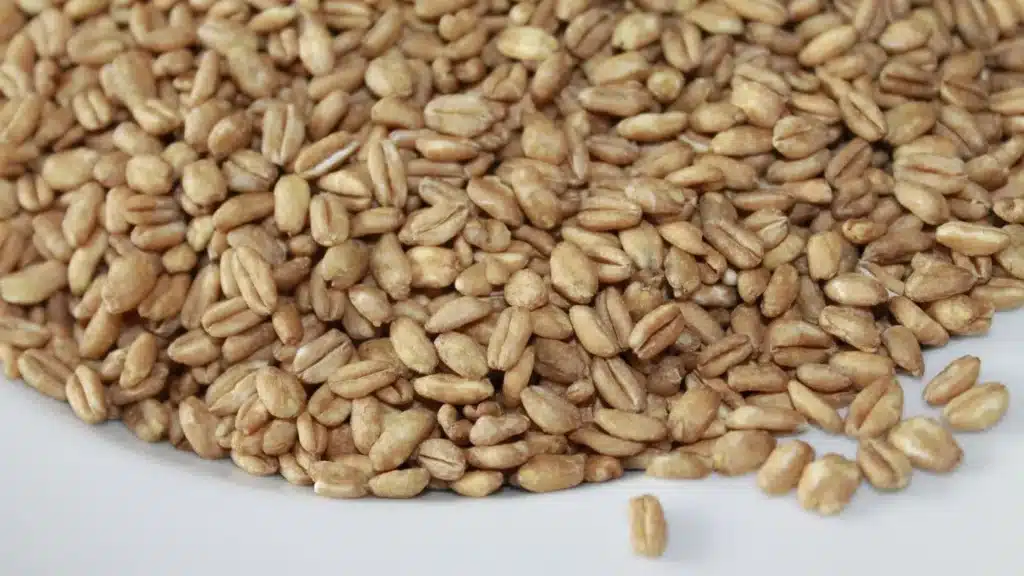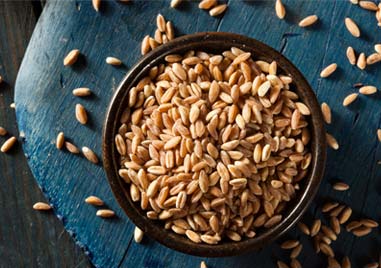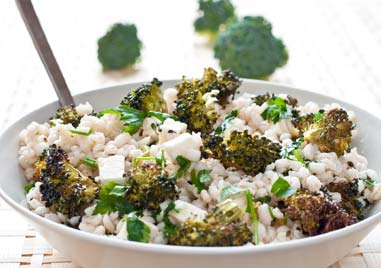How to Cook Farro in a Rice Cooker
Welcome to the world of delicious and nutritious farro! In this article, we’ll dive into the delightful journey of cooking farro in a rice cooker, making your meal prep not only healthier but also incredibly convenient.
If you’re ready to embrace the wonders of this ancient grain, stay with us as we explore the step-by-step process.
What is Farro And type of Farro?

Farro is an ancient whole grain that has been cultivated for thousands of years and is often considered one of the oldest cultivated grains in the world. It’s a type of wheat and a distant relative of modern wheat varieties.
Farro has been a staple in Mediterranean and Middle Eastern cuisines for centuries. It’s known for its nutty flavor, chewy texture, and its versatility in a wide range of dishes.
There are three primary types of farro:
Whole Farro (Farro Integrale): Whole farro is the least processed and retains the bran, germ, and endosperm. This type takes the longest to cook and has the most robust, nutty flavor.
Semi-Pearled Farro (Farro Perlato): Semi-pearled farro has had some of the outer bran layer removed, making it quicker to cook than whole farro. It still retains some of the bran, which gives it a slightly chewy texture.
Pearled Farro (Farro Decorticato): Pearled farro has had most of the bran removed, which results in the shortest cooking time and the softest texture. It’s the most processed form of farro and is often used when a quicker cooking time is desired.
Health Benefits of Farro:

Eating farro offers a multitude of health benefits that can make a positive impact on your overall well-being.
1. Nutrient Powerhouse:
Farro is a nutritional powerhouse, rich in essential vitamins and minerals. It’s a great source of fiber, which aids digestion, and it provides your body with key nutrients like magnesium, zinc, and B vitamins.
2. Heart Health:
Consuming farro may help promote heart health. Its high fiber content can help lower cholesterol levels and reduce the risk of heart disease.
3. Weight Management:
If you’re looking to maintain a healthy weight, farro can be your ally. Its fiber content helps you feel fuller for longer, reducing the urge to snack between meals.
4. Sustained Energy:
Farro’s complex carbohydrates provide a steady source of energy, making it an excellent choice for active individuals or those who want to avoid energy crashes associated with simple carbs.
Unlike some grains, farro has a low glycemic index, which means it doesn’t cause rapid spikes in blood sugar levels.
This can be particularly beneficial for individuals with diabetes or those trying to manage their blood sugar.
6. Bone Health:
Farro contains essential minerals like magnesium and phosphorus, which play a crucial role in maintaining strong and healthy bones. This can be especially important as we age.
7. Versatility:
The versatility of farro allows you to incorporate it into a variety of dishes, making it easy to enjoy its health benefits. You can use it in salads, soups, stews, or as a side dish, adding both flavor and nutrition to your meals.
8. Dietary Diversity:
Including farro in your diet introduces diversity, which is essential for overall health. It provides a different set of nutrients compared to traditional grains like rice or wheat.
Benefits of Using a Rice Cooker for Farro
Why use a rice cooker, you might wonder? Well, the beauty lies in the simplicity. Rice cookers are designed to take the guesswork out of cooking grains. With a rice cooker, you can enjoy hands-free cooking and consistent results every time
Preparing Farro for Cooking

Before we get cooking, it’s essential to prepare your farro properly. Start by rinsing it under cold water. This helps remove excess starch and prevents clumping. Remember, a thorough rinse sets the stage for fluffy farro perfection.
Cooking Farro in a Rice Cooker

Hey, Do you know what the best rice cooker on the market is? If not, you can check out our articles on the best Japanese rice cookers and the best Korean rice cookers to find out which one dominates this field. This will help you choose the best rice cooker that suits your needs
Cooking farro in a rice cooker is a convenient and straightforward process. Here’s a step-by-step guide to help you prepare farro using a rice cooker:
Ingredients:
- Farro
- Water or broth (for cooking)
- Optional: Salt, seasonings, or herbs for flavor
Instructions:
Rinse the Farro: Before cooking, rinse the farro under cold water to remove any excess starch and debris. This helps prevent it from becoming too sticky while cooking.
Measure the Ingredients: Measure the amount of farro you want to cook. A common ratio for cooking farro is 1:2, which means for every cup of farro, you’ll need 2 cups of water or broth. Adjust the quantity based on your needs.
Combine Farro and Liquid: Place the rinsed farro in the rice cooker’s inner pot. Add the measured amount of water or broth, and if desired, a pinch of salt or any seasonings you like. Stir to combine.
Select the Right Setting: Some rice cookers have a specific setting for grains, while others have a standard “white rice” setting. Use the most suitable setting for cooking grains, and if your rice cooker allows, set the cooking time according to the grain type (usually around 45-60 minutes).
Start the Cooking Process: Close the rice cooker’s lid and start the cooking cycle.
Let It Cook: Allow the rice cooker to work its magic. It will automatically control the temperature and timing. Avoid opening the lid during the cooking process, as this can disrupt the cooking cycle.
Check for Doneness: Once the rice cooker indicates that it’s done, open the lid carefully. Use a fork or spoon to check the farro’s doneness. It should be tender with a slight chewiness. If it’s not done to your liking, add a little more water or broth and let it cook for an additional cycle.
Fluff the Farro: After cooking, let the farro sit with the lid closed for a few minutes. Then, use a fork to fluff the farro, separating the grains. This step ensures that the farro is light and fluffy.
Serve: Your cooked farro is ready to serve. You can use it as a base for salads, grain bowls, or side dishes. Season it with additional herbs, spices, or dressings according to your recipe.
Cooking farro in a rice cooker is a convenient way to prepare this grain with minimal effort.
Be aware that the exact cooking time and water-to-farro ratio may vary depending on your rice cooker model and the type of farro you’re using (whole, semi-pearled, or pearled). Adjust as needed to achieve your preferred level of tenderness.
Checking and Fluffing Farro
Checking and fluffing farro is an essential step to ensure that it’s cooked to perfection and has the right texture. Here’s how to do it:
Checking Farro:
- After the cooking cycle in your rice cooker or on the stovetop is complete, do not immediately open the lid.
- Allow the farro to sit, covered, for a few minutes. This resting time helps to evenly distribute the moisture and complete the cooking process.
- After resting, carefully open the lid of the rice cooker or pot. Use a fork or spoon to gently fluff the farro. The grains should appear plump and fully cooked, with a slightly chewy texture.
Fluffing Farro:
- Once you’ve confirmed that the farro is cooked to your desired level of tenderness, it’s time to fluff it to separate the grains and improve the texture.
- Use a fork or a wooden spoon to gently stir and fluff the farro. This process helps prevent clumping and ensures that the grains are evenly distributed.
- Work the utensil through the farro, gently lifting and separating the grains. Avoid pressing down too hard, as this can make the farro mushy.
- If you find that your farro is too sticky or clumped together, you can add a small amount of olive oil or butter while fluffing to help separate the grains and add a bit of richness to the dish. Stir well to distribute the oil or butter.
Remember that the fluffing process is crucial for maintaining the individual grain structure and texture of farro. It also allows you to incorporate additional flavors or seasonings if desired.
Serving Suggestions

Farro is a versatile grain that can be used in a variety of dishes. Here are some serving suggestions for cooked farro:
Farro Salad: Toss cooked farro with a variety of fresh vegetables, such as cherry tomatoes, cucumbers, bell peppers, and red onions. Add some fresh herbs like parsley or basil and dress it with a vinaigrette made from olive oil, lemon juice, and your choice of vinegar. You can also add feta cheese, olives, or roasted nuts for extra flavor and texture.
Grain Bowl: Create a nourishing grain bowl by topping a serving of cooked farro with your favorite proteins, such as grilled chicken, roasted vegetables, tofu, or a poached egg. Add some leafy greens, avocado, and a drizzle of sauce or dressing for a complete and satisfying meal.
Side Dish: Serve farro as a side dish alongside grilled or roasted meats and fish. It pairs well with a variety of proteins and can be seasoned with herbs, spices, and a drizzle of olive oil for added flavor.
Soup or Stew Thickener: Farro can be used to thicken soups and stews, adding a hearty and nutty flavor to the dish. Simply cook the farro separately and add it to the soup or stew towards the end of the cooking process.
Breakfast Porridge: Cook farro with milk or a milk alternative, sweeten it with honey or maple syrup, and top it with fresh or dried fruits, nuts, and a sprinkle of cinnamon for a warm and filling breakfast porridge.
Stuffing: Use cooked farro as a base for stuffing poultry, such as chicken or turkey. Combine it with sautéed vegetables, herbs, and spices to create a flavorful stuffing mixture.
Cold Packed Lunch: Farro makes an excellent addition to packed lunches. Pack a container of cold, cooked farro and pair it with your choice of proteins, veggies, and a tasty sauce or dressing. It’s a great alternative to traditional sandwiches or salads.
Pilaf: Prepare a farro pilaf by sautéing it with onions, garlic, and your favorite seasonings in a little oil. Then, add vegetable or chicken broth and simmer until the liquid is absorbed. You can also incorporate ingredients like dried fruit, nuts, or vegetables for added flavor.
Fried Farro: Make a savory dish by stir-frying cooked farro with various ingredients like vegetables, shrimp, chicken, or tofu. Season it with soy sauce, ginger, garlic, and other preferred seasonings for a tasty stir-fry.
Desserts: Farro can also be used in desserts. Cook it with milk, sweeten it, and add flavors like vanilla and cinnamon. Then, top it with fruits and nuts for a unique dessert or sweet breakfast option.
Storing Cooked Farro
Got leftovers? No worries! Store cooked farro in an airtight container in the refrigerator for up to a week. To reheat, add a splash of water and warm it in the microwave or on the stovetop, keeping the grains moist and tasty.
Troubleshooting Tips

Cooking farro in a rice cooker can be a convenient way to prepare this hearty grain. However, you might encounter some issues along the way. Here are troubleshooting tips to help you cook farro in a rice cooker successfully:
Rinse the Farro: Before cooking, rinse the farro under cold water. This removes excess starch and prevents it from becoming too sticky in the rice cooker.
Use the Right Ratio: Typically, the ratio for cooking farro in a rice cooker is 1:2. That means for every cup of farro, use 2 cups of water. Adjust the water amount according to your rice cooker’s instructions and your desired farro texture.
Soak the Farro: If you have the time, soak the farro for a few hours or overnight before cooking. This can help reduce the cooking time.
Select the Appropriate Setting: Many rice cookers have different settings, such as white rice, brown rice, and even a specific grain setting. Use the setting that corresponds to the farro you are cooking. If your rice cooker doesn’t have a specific setting, the white rice setting or the regular setting should work fine.
Add Flavor: To enhance the taste, you can add seasonings like salt, herbs, or even a bouillon cube to the cooking water. This can give your farro a more robust flavor.
Check the Timer: Some rice cookers have a timer function, which can be very convenient. Make sure you set the timer correctly, especially if you soaked the farro, as it may require less cooking time.
Avoid Opening the Lid: As with rice, avoid opening the rice cooker lid during cooking. This can release steam and disrupt the cooking process.
Check for Doneness: Once the rice cooker completes its cycle, check the farro for doneness. It should be tender but still slightly chewy. If it’s not done, you can add a little more water and run the rice cooker for an additional cycle.
Stir and Fluff: After cooking is complete, let the farro sit with the lid closed for a few minutes. Then, fluff it with a fork to separate the grains.
Adjust for Future Attempts: If you find that your farro is consistently undercooked or overcooked in the rice cooker, make adjustments to the water-to-farro ratio or cooking time for your specific rice cooker.
Remember that rice cookers vary, so it may take some trial and error to find the perfect settings for your particular rice cooker. These troubleshooting tips should help you get your farro just right in a rice cooker.
Recipe Ideas to cook Farro in rice cooker
Here are a couple of recipe ideas to inspire your readers once they’ve learned how to cook farro in a rice cooker:
1. Farro and Roasted Vegetable Salad

Ingredients:
- 1 cup cooked farro
- Assorted vegetables (e.g., bell peppers, cherry tomatoes, zucchini, red onion)
- Olive oil
- Salt and pepper
- Fresh herbs (such as basil or parsley)
- Balsamic vinegar or lemon juice (for dressing)
- Feta cheese (optional)
Instructions:
Toss the assorted vegetables in olive oil, salt, and pepper. Roast them in the oven until they’re tender and slightly caramelized.
In a large bowl, combine the cooked farro and roasted vegetables.
Drizzle with balsamic vinegar or lemon juice for a bright and tangy dressing.
Add fresh herbs for extra flavor and color.
If desired, crumble some feta cheese over the top for a creamy finish.
If you loved high quality rice cooker. Check Pick List about best Japanese rice cooker
2. Farro and Mushroom Risotto

Ingredients:
- 1 cup cooked farro
- 2 cups mushrooms (sliced)
- 1 small onion (finely chopped)
- 2 cloves garlic (minced)
- Olive oil
- 1/2 cup dry white wine (optional)
- 3 cups vegetable or chicken broth
- Parmesan cheese (grated)
- Salt and pepper to taste
- Fresh thyme (optional)
Instructions:
In a large skillet, heat olive oil over medium heat. Add the chopped onion and cook until translucent.
Add the minced garlic and sliced mushrooms to the skillet. Sauté until the mushrooms are browned and tender.
If using, pour in the white wine and cook until it reduces by half.
Add the cooked farro to the skillet and stir to combine.
Begin adding the broth gradually, one ladle at a time, stirring constantly. Allow the liquid to absorb before adding more.
Continue this process until the farro is creamy and cooked to your desired consistency (about 20-30 minutes).
Stir in grated Parmesan cheese and season with salt and pepper. Add fresh thyme for an extra burst of flavor.
Serve your farro and mushroom risotto hot, garnished with additional Parmesan and thyme if desired.
Conclusion
Congratulations! You’ve just unlocked the secret to perfectly cooked farro in a rice cooker. It’s a game-changer in your kitchen, offering both health and convenience. Experiment, enjoy, and don’t hesitate to share your culinary creations with friends and family.
hey, If you want Cook Lentils in a Rice Cooker, don’t miss it
